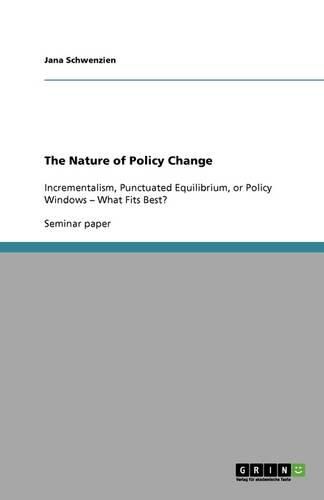Readings Newsletter
Become a Readings Member to make your shopping experience even easier.
Sign in or sign up for free!
You’re not far away from qualifying for FREE standard shipping within Australia
You’ve qualified for FREE standard shipping within Australia
The cart is loading…






Seminar paper from the year 2009 in the subject Politics - Methods, Research, grade: 1,7, University of Potsdam (Wirtschafts- und Sozialwissenschaftliche Fakultat), course: Theories of Public Policy, language: English, abstract: Politics and media announce that we need a major policy change regarding the forthcoming problems and challenges related to climate change. But what is policy change? Policy change in this paper is understood as a major change or reversal in attitude or principle or point of view. But when and how does such changes happen? This work aims to look at policy change from a theoretical point of view by contrasting three different theoretical approaches regarding their explanatory power for policy change. The paper deals with Lindblom’s incrementalism (1959; 1979), Kingdon’s policy windows (1995), as well as Baumgartner and Jones’s theory of punctuated equilibrium (1991). The theories and concepts of agenda setting and policy change are closely related in the literature on policy making. Since Lindblom’s The Science of Muddling Through (1959), patterns of policy change were analyzed regarding different elements such as policy entrepreneurship (Kingdon 1984; 1995) or issue expansion and venue shopping (Baumgartner and Jones 1991). Roughly spoken there are two competing views on changes in policy making in the literature: the stability in policy making and the incremental nature of policy change as introduced by Lindblom (1959), and episodes of abrupt changes elaborated by Baumgartner and Jones in their punctuated equilibrium theory (1991; 1993). Most studies of agenda setting focus only on a narrow set of theoretical principles, thus producing incomplete and sometimes conflicting explanations for policy change. The theoretical frameworks by Lindblom, Kingdon, and Baumgartner and Jones take different views concerning the type of policy change. The aim of this essay is to take a closer look in order to determine whether these three approaches are c
$9.00 standard shipping within Australia
FREE standard shipping within Australia for orders over $100.00
Express & International shipping calculated at checkout
Seminar paper from the year 2009 in the subject Politics - Methods, Research, grade: 1,7, University of Potsdam (Wirtschafts- und Sozialwissenschaftliche Fakultat), course: Theories of Public Policy, language: English, abstract: Politics and media announce that we need a major policy change regarding the forthcoming problems and challenges related to climate change. But what is policy change? Policy change in this paper is understood as a major change or reversal in attitude or principle or point of view. But when and how does such changes happen? This work aims to look at policy change from a theoretical point of view by contrasting three different theoretical approaches regarding their explanatory power for policy change. The paper deals with Lindblom’s incrementalism (1959; 1979), Kingdon’s policy windows (1995), as well as Baumgartner and Jones’s theory of punctuated equilibrium (1991). The theories and concepts of agenda setting and policy change are closely related in the literature on policy making. Since Lindblom’s The Science of Muddling Through (1959), patterns of policy change were analyzed regarding different elements such as policy entrepreneurship (Kingdon 1984; 1995) or issue expansion and venue shopping (Baumgartner and Jones 1991). Roughly spoken there are two competing views on changes in policy making in the literature: the stability in policy making and the incremental nature of policy change as introduced by Lindblom (1959), and episodes of abrupt changes elaborated by Baumgartner and Jones in their punctuated equilibrium theory (1991; 1993). Most studies of agenda setting focus only on a narrow set of theoretical principles, thus producing incomplete and sometimes conflicting explanations for policy change. The theoretical frameworks by Lindblom, Kingdon, and Baumgartner and Jones take different views concerning the type of policy change. The aim of this essay is to take a closer look in order to determine whether these three approaches are c